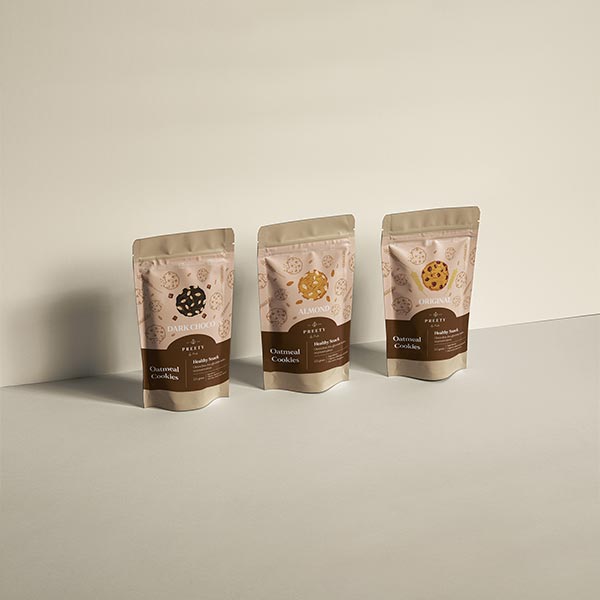Introduction to Cookie Packaging Bags
In the realm of sweet indulgences, cookies hold a special place. Whether it’s a classic chocolate chip or a delicate shortbread, cookies are universally loved treats. However, their journey from the oven to the consumer’s hands involves careful consideration, especially when it comes to packaging. This article delves into the world of cookie packaging bags, exploring their importance, types, factors to consider, benefits, and more.
Importance of Packaging in the Food Industry
Packaging plays a pivotal role in the food industry, serving multiple purposes beyond mere containment. For cookies, it’s not just about preserving freshness but also about presenting them attractively to consumers. A well-packaged cookie not only maintains its taste and texture but also entices customers with its visual appeal.
Types of Cookie Packaging Bags
Plastic Bags
Plastic bags are a popular choice for cookie packaging due to their versatility and affordability. They come in various sizes and can be transparent or opaque, allowing customers to see the tempting treats inside. However, there are concerns about the environmental impact of plastic, leading many businesses to seek alternative options.
Paper Bags
Paper bags offer a more eco-friendly alternative to plastic. They are biodegradable and can be recycled, making them a preferred choice for environmentally-conscious consumers. Additionally, paper bags can be customized with vibrant designs and logos, adding to the overall branding of the product.
Cellophane Bags
Cellophane bags provide a transparent and glossy finish, making them ideal for showcasing the intricate details of artisanal cookies. They are lightweight, moisture-resistant, and offer excellent visibility, making them a popular choice for bakeries and specialty stores.
Factors to Consider When Choosing Cookie Packaging Bags
When selecting cookie packaging bags, several factors should be taken into account to ensure optimal preservation and presentation:
Material
The choice of material influences the freshness and shelf life of the cookies. It’s essential to select packaging that offers proper barrier properties to prevent moisture and air from compromising the product quality.
Size
The size of the packaging should accommodate the quantity and size of the cookies while allowing for easy handling and storage. Oversized packaging can lead to excess air exposure, resulting in stale cookies, while undersized packaging may damage the treats.
Design
The design of the packaging plays a significant role in capturing the attention of consumers. Eye-catching graphics, vibrant colors, and innovative shapes can enhance the visual appeal of the cookies and distinguish them from competitors.
Sealability
A secure seal is crucial for maintaining the freshness and integrity of the cookies. Whether it’s a resealable zipper, heat seal, or twist tie, ensuring a tight seal prevents moisture and contaminants from entering the packaging.
Benefits of Using Cookie Packaging Bags
The use of cookie packaging bags offers several benefits for both businesses and consumers:
- Freshness Preservation: Proper packaging helps extend the shelf life of cookies by protecting them from moisture, air, and external contaminants.
- Branding Opportunity: Customized packaging allows businesses to showcase their brand identity and create a memorable impression on customers.
- Convenience: Convenient packaging options such as resealable bags make it easy for consumers to enjoy cookies on the go and store them for later consumption.
- Eco-Friendliness: Environmentally-friendly packaging options reduce the carbon footprint and appeal to eco-conscious consumers.
Tips for Effective Cookie Packaging
To ensure effective cookie packaging, consider the following tips:
- Choose high-quality packaging materials that offer adequate protection and preserve freshness.
- Incorporate branding elements such as logos, slogans, and product descriptions to enhance brand recognition.
- Pay attention to packaging design and aesthetics to create a visually appealing product presentation.
- Provide clear labeling with product information, ingredients, and nutritional details to inform consumers and build trust.
- Invest in sustainable packaging solutions to align with consumer preferences and environmental initiatives.
Environmental Considerations
In recent years, there has been a growing awareness of the environmental impact of packaging materials. Businesses are increasingly adopting sustainable packaging practices, such as using biodegradable materials, minimizing packaging waste, and implementing recycling programs. By prioritizing eco-friendly packaging solutions, companies can reduce their carbon footprint and appeal to environmentally-conscious consumers.
Trends in Cookie Packaging
The cookie packaging industry is witnessing several trends that reflect changing consumer preferences and market demands:
- Minimalist Packaging: Clean and simple designs that focus on the product’s quality and ingredients.
- Sustainable Materials: The use of recyclable and biodegradable materials to reduce environmental impact.
- Personalization: Customized packaging options that allow consumers to create unique gifts and experiences.
- Convenience Features: Innovative packaging designs with resealable closures, portion control options, and easy-open features for added convenience.
Conclusion
In the competitive world of food retail, cookie packaging plays a crucial role in attracting customers, preserving freshness, and building brand loyalty. By choosing the right packaging materials, designs, and strategies, businesses can create a memorable and satisfying experience for consumers while contributing to environmental sustainability.


